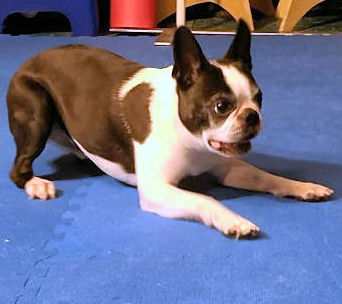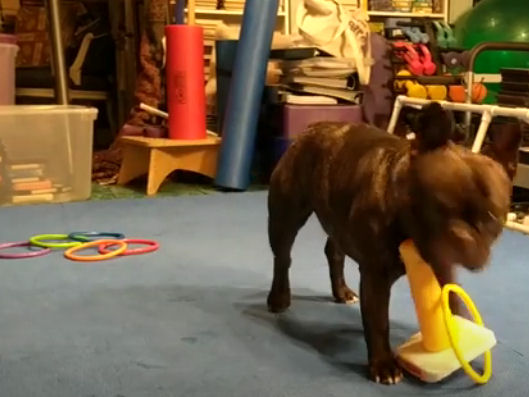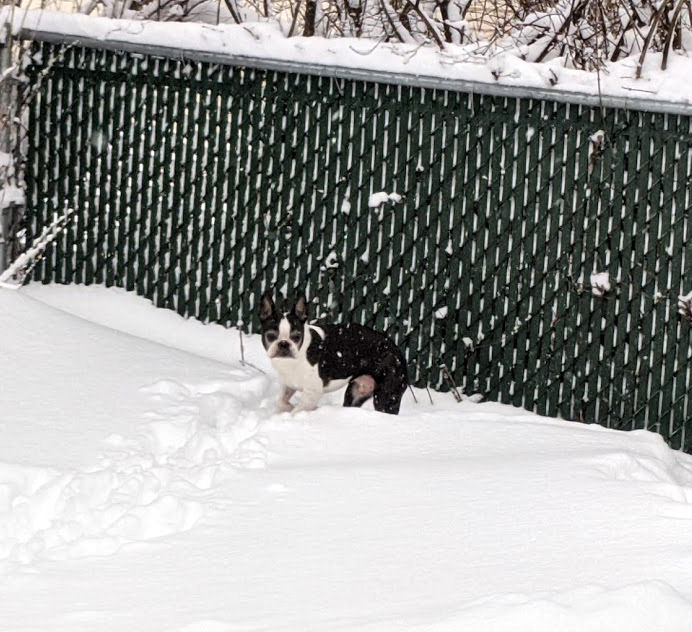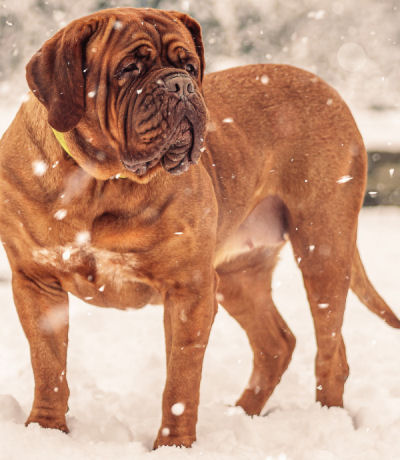
This week we were called upon to help a dog afraid of loud noises. It’s not your typical case. Peanut is a Mastiff. Not a toy dog, not a “lap dog.” Peanut weighs more than we do.
Peanut is about three years old now. We met him when he was a puppy, just twice as big as Hope’s French Bulldog, Torque. Peanut’s always been timid, but puppy class helped and he was doing well with consistent exposure to different situations.
Pandemic shut-down
And then the pandemic struck. Peanut and his family have had limited contact with the outside world for almost a year. For easy-going dogs, it’s probably not as critical an issue. For Peanut, it stopped his progress in its tracks.
His owners are a lovely, active couple who make sure their dog gets plenty of exercise and goes for long walks daily. They even made sure he got out in the worst weather. On truly bad days, the husband would take Peanut out for a walk and, if they got too cold or it was too sloppy, they’d call for a ride to get home.
Which is where the issue with noises arises.
Two facets of a single problem
Peanut needs a ramp to get up into their car. They can’t lift him – he’s over 100 pounds. One day last week the ramp dropped away from the car and made a loud noise on the garage floor. Peanut was terrified. He wouldn’t go near the ramp again. It took them hours to convince him out of the car.
They just didn’t know how to help their dog. They replaced the ramp with a different one, but Peanut wouldn’t go anywhere near it.
Wisely, they called for help. A single issue, the dog’s fear of loud noises, has two different training solutions. One to address the ramp issue. The second is changing Peanut’s noise phobia.
To get Peanut to use a car ramp again, Peanut has to love the ramp. Now it’s a fear object, with all the terror of the noise itself attached to the ramp.
To get Peanut over being afraid of loud noises, he has to learn to ignore them.
Learning to love again
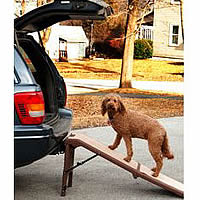
The ramp aversion is the more immediate problem, since Peanut won’t be able to go anywhere if he won’t use the ramp. An added complication for them – Peanut has severe food sensitivities and is a lackluster eater at the best of times. Fortunately, he is toy-motivated and loves to play with his toys.
Since this is an intense situation, we’ve set some rules for Peanut. All of his toys, every single one, has been removed from the household and hidden in a bin only the people have access to. Several times a day, they take a toy and stand by the ramp. When Peanut puts a paw on the ramp, he gets to play tug with the toy and person. Only if he puts a paw on the ramp.
What we’re doing is attempting to transfer the value of something Peanut loves (his toy) to something he avoids (the ramp). Everybody’s going to have to be patient. Overcoming fear isn’t fast. And Peanut’s fear may be more powerful than his love for his toy at first. Ultimately Peanut will learn to love the ramp – he’ll associate the best rewards with it. (Read more on this: https://2-minute-trainer.com/2020/05/01/all-behaviors-are-equal/)
When Peanut is stepping on the ramp with a single paw fairly consistently, the next step will be to wait for two paws. And reward with play. Then three, and four. Then walking consistently.
Small steps
Peanut’s owners may also face a problem when they move the ramp. Right now it’s in their family room while they address their dog’s fear of loud noises. When they make progress, it will have to move to the garage. And the process may have to start all over again.
We’ve talked before about dogs not being able to generalize. Once people learn to use a spoon, all spoons “work” the same way, regardless of what they look like or where they are. That’s generalizing. Dogs don’t make the same mental leap. A ramp in the family room may not be the same as a ramp in the garage.
Fear of loud noises
The other part of the issue Peanut’s owners need to address is their dog’s fear of loud noises. Contrarily, we don’t want Peanut to love noise. Instead, he needs to learn to ignore it.
In separate training sessions from his ramp game, his owners are going to make their household much louder. One of them will bang pots while the other plays tug with Peanut. Or yell across the house at each other. Or play loud music, or explosion recordings, or fireworks or thunder. If Peanut learns that noise is just a part of life, his life will be less fearful, more fun, and improve immensely.
Get loud
If your dog is afraid of loud noises, try pairing noise with things your dog enjoys. If your dog is food motivated, it’s a little easier for you. Just play those loud recordings during your dog’s mealtimes. Even better if you feed by hand and ask your dog to do “stuff” during meals.
Trying to turn around an established pattern may be difficult, but it’s not impossible. Take it step by step and change the fear into a trigger for something good and/or fun to happen. You and your dog will both be happier if you can overcome the fear of loud noises.

